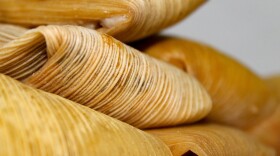Hello Radio Readers! Dana Waters from Fowler, Kansas, here. When I read Mark Kurlansky’s Edible Stories: A Novel in Sixteen Parts, I found the oysters in the story titled “Belons” especially intriguing. Wouldn’t it be fun to compare the Belons to the Portugaises, paired with a bottle of Sancerre of course? I’m thinking a small Paris café, since Belons are probably not a High Plains specialty, right?
We on the High Plains do, however, have our own version of Belons: mountain oysters. As delicious as Belons may be, it would be hard to beat a mess of good mountain oysters. It is true some of us have been disappointed by ordering calf fries in a restaurant and getting dry or rubbery mountain oysters, but that doesn’t discourage a true native of the High Plains.
We merely take our craving to a better venue. We have sampled the best: fried up by ranchers and farmers to share with a yard or a shed full of friends and neighbors. Sliced thin, dipped in egg wash and dusted in finely crumbled crackers, then fried crispy and tender, our oysters hardly hit the platter before they are gone. Friends stand around the cooking fire, cold beer in hand, waiting for the cook to dump the new batch onto the platter. Pair our High Plains oysters with a zesty cocktail sauce and a few choice salads, and a farm shed with picnic tables and camp chairs acquires every bit as much appeal as a small Paris bistro with an oyster shucker outside.
The camaraderie of a mountain oyster fry is a tradition shared with friends and neighbors of my family for at least three generations. My husband’s father fried them up in a giant cast iron skillet that hung on the well house wall. My husband used the same skillet, but my sons have up-dated to a deep-fat fryer.
One son claims that our mountain oysters are so tender and rich because they clean them, skinning the nuts down to the last membrane, and pop them into the freezer in plastic bags as soon as they’ve finished working the calves. “Fresh,” he says. “You never leave them sitting around in buckets in a hot working shed,” he adds, a disgusted look on his face.
When it’s time for a fry, take the nuts out and let them just begin to thaw. While they are still mostly frozen—very firm—the nuts will pop right out of the last skin and you can slice them easily. If you let the nuts thaw more, they will just squash into a muddled mass that is nearly impossible to skin and slice. Slice them thin—no more than a quarter inch thick. (Here my son holds up his fingers to show me. It is hard to see the width between his thick fingers, so my daughter-in-law offers, “About a quarter of an inch.”)
Dredge the slices through an egg beaten together with a little milk, then through finely crushed saltine crackers. Season the crackers with a little garlic salt if you like. Drop the coated fries into the hot oil and fry them until they float. It doesn’t take long. Dump them, golden and crisp, onto a platter and watch them disappear as you turn to the next batch. Good luck with trying to serve them piled in a pan! They will probably never make it that far.
Serve these tender bites hot with a cocktail sauce (ketchup and horseradish works well), and you have shared with your guests the finest treat the High Plains offers: Mountain Oysters! Bon appetit!








